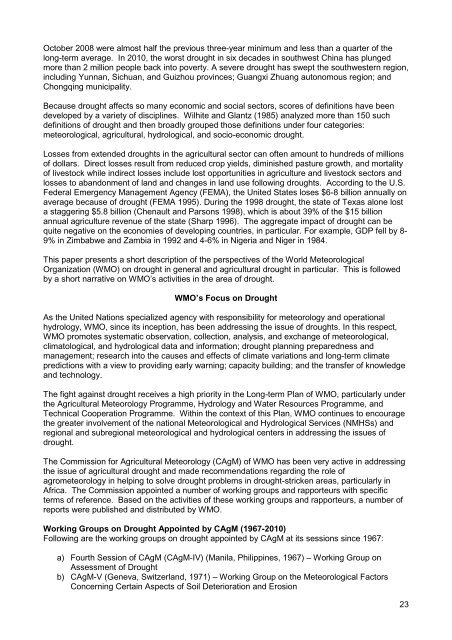Agricultural Drought Indices - US Department of Agriculture
Agricultural Drought Indices - US Department of Agriculture
Agricultural Drought Indices - US Department of Agriculture
You also want an ePaper? Increase the reach of your titles
YUMPU automatically turns print PDFs into web optimized ePapers that Google loves.
October 2008 were almost half the previous three-year minimum and less than a quarter <strong>of</strong> the<br />
long-term average. In 2010, the worst drought in six decades in southwest China has plunged<br />
more than 2 million people back into poverty. A severe drought has swept the southwestern region,<br />
including Yunnan, Sichuan, and Guizhou provinces; Guangxi Zhuang autonomous region; and<br />
Chongqing municipality.<br />
Because drought affects so many economic and social sectors, scores <strong>of</strong> definitions have been<br />
developed by a variety <strong>of</strong> disciplines. Wilhite and Glantz (1985) analyzed more than 150 such<br />
definitions <strong>of</strong> drought and then broadly grouped those definitions under four categories:<br />
meteorological, agricultural, hydrological, and socio-economic drought.<br />
Losses from extended droughts in the agricultural sector can <strong>of</strong>ten amount to hundreds <strong>of</strong> millions<br />
<strong>of</strong> dollars. Direct losses result from reduced crop yields, diminished pasture growth, and mortality<br />
<strong>of</strong> livestock while indirect losses include lost opportunities in agriculture and livestock sectors and<br />
losses to abandonment <strong>of</strong> land and changes in land use following droughts. According to the U.S.<br />
Federal Emergency Management Agency (FEMA), the United States loses $6-8 billion annually on<br />
average because <strong>of</strong> drought (FEMA 1995). During the 1998 drought, the state <strong>of</strong> Texas alone lost<br />
a staggering $5.8 billion (Chenault and Parsons 1998), which is about 39% <strong>of</strong> the $15 billion<br />
annual agriculture revenue <strong>of</strong> the state (Sharp 1996). The aggregate impact <strong>of</strong> drought can be<br />
quite negative on the economies <strong>of</strong> developing countries, in particular. For example, GDP fell by 8-<br />
9% in Zimbabwe and Zambia in 1992 and 4-6% in Nigeria and Niger in 1984.<br />
This paper presents a short description <strong>of</strong> the perspectives <strong>of</strong> the World Meteorological<br />
Organization (WMO) on drought in general and agricultural drought in particular. This is followed<br />
by a short narrative on WMO’s activities in the area <strong>of</strong> drought.<br />
WMO’s Focus on <strong>Drought</strong><br />
As the United Nations specialized agency with responsibility for meteorology and operational<br />
hydrology, WMO, since its inception, has been addressing the issue <strong>of</strong> droughts. In this respect,<br />
WMO promotes systematic observation, collection, analysis, and exchange <strong>of</strong> meteorological,<br />
climatological, and hydrological data and information; drought planning preparedness and<br />
management; research into the causes and effects <strong>of</strong> climate variations and long-term climate<br />
predictions with a view to providing early warning; capacity building; and the transfer <strong>of</strong> knowledge<br />
and technology.<br />
The fight against drought receives a high priority in the Long-term Plan <strong>of</strong> WMO, particularly under<br />
the <strong>Agricultural</strong> Meteorology Programme, Hydrology and Water Resources Programme, and<br />
Technical Cooperation Programme. Within the context <strong>of</strong> this Plan, WMO continues to encourage<br />
the greater involvement <strong>of</strong> the national Meteorological and Hydrological Services (NMHSs) and<br />
regional and subregional meteorological and hydrological centers in addressing the issues <strong>of</strong><br />
drought.<br />
The Commission for <strong>Agricultural</strong> Meteorology (CAgM) <strong>of</strong> WMO has been very active in addressing<br />
the issue <strong>of</strong> agricultural drought and made recommendations regarding the role <strong>of</strong><br />
agrometeorology in helping to solve drought problems in drought-stricken areas, particularly in<br />
Africa. The Commission appointed a number <strong>of</strong> working groups and rapporteurs with specific<br />
terms <strong>of</strong> reference. Based on the activities <strong>of</strong> these working groups and rapporteurs, a number <strong>of</strong><br />
reports were published and distributed by WMO.<br />
Working Groups on <strong>Drought</strong> Appointed by CAgM (1967-2010)<br />
Following are the working groups on drought appointed by CAgM at its sessions since 1967:<br />
a) Fourth Session <strong>of</strong> CAgM (CAgM-IV) (Manila, Philippines, 1967) – Working Group on<br />
Assessment <strong>of</strong> <strong>Drought</strong><br />
b) CAgM-V (Geneva, Switzerland, 1971) – Working Group on the Meteorological Factors<br />
Concerning Certain Aspects <strong>of</strong> Soil Deterioration and Erosion<br />
23

















